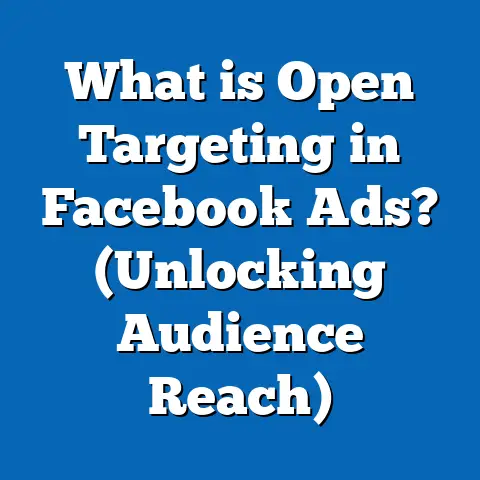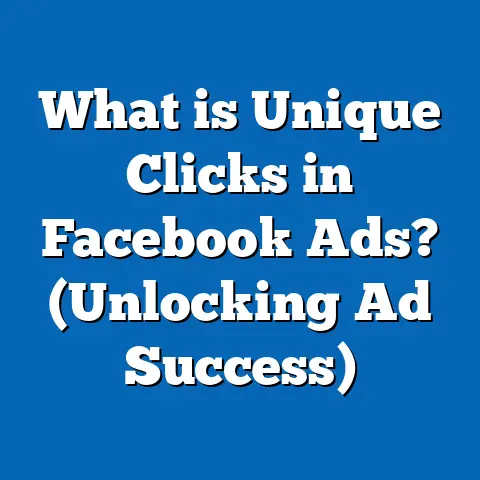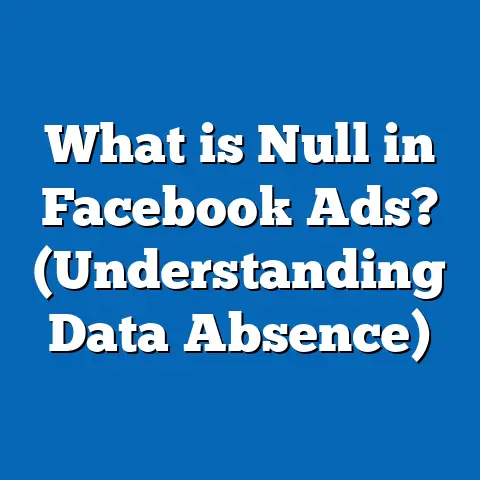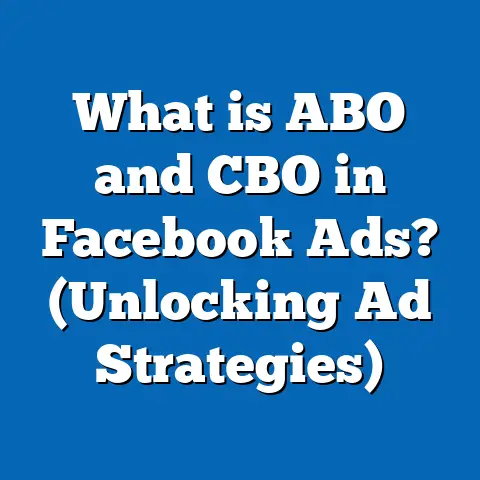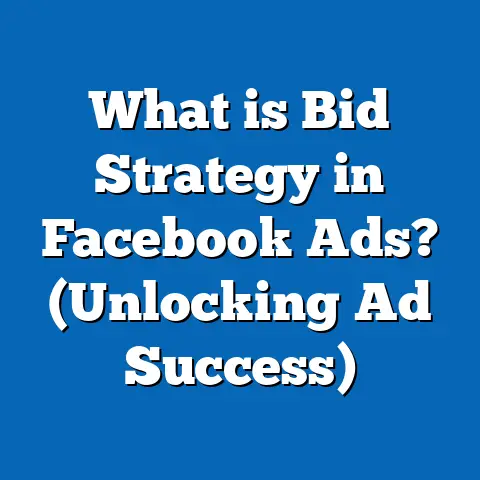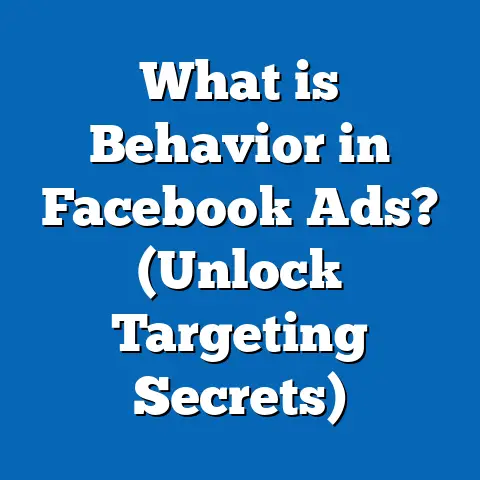What is the Facebook Ads Learning Phase Duration? (Unlock Success)
What is the Facebook Ads Learning Phase Duration? (Unlock Success)
Introduction: The Future of Facebook Advertising
Digital advertising is constantly evolving, and Facebook Ads remain a cornerstone for businesses aiming to connect with millions of potential customers worldwide. However, simply running ads on Facebook is no longer enough. The platform’s sophisticated machine learning-driven delivery system demands a strategic approach to maximize campaign success.
At the heart of this strategy lies the Facebook Ads Learning Phase — a critical period when Facebook’s algorithm gathers data to optimize your ad delivery. Understanding the nuances of this phase, its duration, and how to influence it can dramatically improve your ad performance and reduce wasted spend.
Section 1: Deep Dive into the Facebook Ads Learning Phase
What Exactly is the Learning Phase?
The learning phase is an initial period after launching or editing a Facebook ad set during which the delivery system collects data on how your ads perform with different audience segments and placements. This data allows Facebook’s machine learning models to optimize ad delivery toward users most likely to take your desired action.
Think of it as the algorithm “experimenting” with different variables to find the best combination for your campaign goal — whether that’s conversions, leads, clicks, or engagements.
Why Facebook Needs a Learning Phase
Facebook’s ad delivery system uses complex machine learning algorithms that rely on user behavior data to serve ads efficiently. When you start a new campaign or make major changes (e.g., budget increase, targeting changes), the system needs fresh data to:
- Understand which audience groups respond best
- Determine optimal time and placement for ads
- Adjust bids dynamically for cost efficiency
Without this learning, the algorithm cannot reliably predict who will convert, leading to erratic performance and higher costs.
Technical Definition of Learning Phase Duration
Facebook officially defines the learning phase as ending once an ad set receives around 50 optimization events within a rolling 7-day period. An optimization event is an action aligned with your campaign objective — for example, a purchase, lead submission, or landing page view.
Until these 50 events occur, your ad set is considered to be in the learning phase. This threshold is necessary because machine learning models require sufficient data points before confidently predicting which audience segments will deliver results at scale.
What Happens During the Learning Phase?
During this period:
- Facebook tests different subsets of your audience.
- It experiments with various placements (News Feed, Stories, Messenger).
- Bid strategies are adjusted dynamically.
- Ad creatives are evaluated for engagement and effectiveness.
Due to this testing, performance can fluctuate significantly during the learning phase — costs may be higher, and results less predictable.
In-Depth Statistics & Data Insights
Data from Facebook’s own studies show:
- Campaigns that exit the learning phase see up to 20-25% lower cost per result.
- On average, ad sets take 3-7 days to exit learning if they meet event thresholds.
- Ad sets that do not reach 50 events often remain in learning longer or become “learning limited,” resulting in inefficient spending.
Independent Research & Case Studies
A detailed analysis by AdEspresso involving over 10,000 campaigns revealed:
| Optimization Events | Average Learning Duration | Cost Efficiency Improvement After Exit |
|---|---|---|
| < 20 | 10+ days | < 5% |
| 20 – 50 | 7 – 10 days | 10 – 15% |
| > 50 | 3 – 7 days | 20 – 25% |
This data highlights the direct correlation between event volume and both learning duration and campaign cost efficiency.
Section 2: Breaking Down Optimization Events and Their Impact
Understanding Optimization Events in Detail
An optimization event is a specific action Facebook tracks that aligns with your campaign objective. Common examples include:
- Conversions: Purchases, add-to-cart actions, completed checkouts
- Lead Generation: Form submissions or sign-ups
- Engagement: Likes, comments, shares on posts
- Traffic: Clicks to websites or app installs
When setting up your campaign, you choose which event to optimize for based on your business goal. The algorithm then prioritizes delivering ads to users most likely to complete that event.
How Optimization Events Affect Learning Phase Duration
The frequency of your chosen optimization event directly impacts how quickly you reach the 50-event threshold. For example:
- If optimizing for purchases in a niche market with low volume, it may take longer to reach 50 purchases.
- Optimizing for link clicks or add-to-cart actions (higher frequency events) allows faster data collection.
Practical Example: Choosing the Right Optimization Event
A fitness apparel brand initially optimized for purchase events but struggled to exit the learning phase due to few purchases daily. By switching optimization to “Add to Cart” events—more frequent but still meaningful—their ad sets exited learning in under a week while maintaining high purchase rates downstream.
Section 3: Factors Influencing Learning Phase Duration
Budget Size
Your daily campaign budget has a huge impact on how quickly you accumulate optimization events. A low budget may limit impressions and actions per day, extending the learning phase.
Rule of Thumb:
Set a budget that aligns with expected cost per optimization event multiplied by 50 (the event threshold). For example:
If your average cost per purchase is $20: $ \text{Recommended daily budget} = 50 \times 20 = $1000 $ This ensures sufficient spend to gather data quickly.
Audience Size and Quality
Broader audiences generate more impressions and interactions faster than highly narrow segments. However, overly broad audiences can reduce relevance and increase wasted spend.
Finding a balance between audience size (ideally between 100k – 1 million active users) and quality is key.
Campaign Objective and Industry Benchmarks
Different industries and objectives have varying event frequencies:
| Campaign Objective | Typical Event Frequency | Learning Phase Duration Estimate |
|---|---|---|
| Conversions (Purchases) | Low-medium (varies by product) | 5-10 days or longer |
| Lead Generation | Medium-high | 3-7 days |
| Traffic / Link Clicks | High | 1-3 days |
| Engagement | Very high | <1 day |
Knowing industry benchmarks helps set realistic expectations.
Seasonality & Market Competition
During high demand periods (holidays, sales), more competition increases costs and may slow down learning due to fewer impressions within budget. Off-seasons might allow faster learning but fewer conversions.
Section 4: Common Challenges & How to Overcome Them
Challenge #1: Stuck in Learning Phase (Learning Limited Status)
When ad sets do not reach 50 optimization events within seven days or your budget is too low relative to the goal cost per event, Facebook marks them as “Learning Limited.” This indicates poor data collection and unstable delivery.
How To Fix:
- Increase daily budget.
- Broaden audience targeting.
- Choose a higher-frequency optimization event.
- Avoid frequent edits/resetting learning.
Challenge #2: Frequent Edits Reset Learning Progress
Even small changes like modifying budget by more than 20%, changing bid strategy, or altering targeting reset the learning phase clock. This wastes valuable time and money.
Best Practice:
Finalize your ad set details before launch as much as possible. Make incremental changes only after exiting learning or during campaign scaling phases.
Challenge #3: Low Volume of Optimization Events
Niche products or services with naturally low conversion rates struggle to meet event thresholds quickly.
Solutions:
- Use higher-funnel objectives (e.g., “Add to Cart” instead of purchases).
- Run retargeting campaigns with broader goals.
- Combine multiple campaigns for aggregated data insights.
Section 5: Practical Tips & Strategies for Mastering Learning Phase
Tip #1: Use Campaign Budget Optimization (CBO)
CBO lets Facebook automatically allocate budgets across multiple ad sets based on performance signals. This can speed up data gathering by focusing spend on best-performing ad sets and shortening their learning phases collectively.
Tip #2: Leverage Automatic Placements
Allowing Facebook to run ads across all placements (Facebook Feed, Instagram Stories, Audience Network) increases impressions volume and variety of interaction points—accelerating learning.
Tip #3: Test Broad Audiences First
Starting broad helps generate enough optimization events quickly. Once out of learning phase, narrow audiences progressively for better targeting without sacrificing delivery stability.
Tip #4: Optimize for Value-Based Lookalikes
Create lookalike audiences based on customer value rather than just acquisition. These audiences often perform better and generate more frequent optimization events faster.
Tip #5: Monitor “Learning Limited” Status Closely
Use Ads Manager’s delivery insights tab regularly. If an ad set is “learning limited,” act promptly to adjust settings or budgets before wasting spend.
Section 6: Real World Case Studies Demonstrating Learning Phase Management
Case Study #1: E-Commerce Apparel Brand
Background: New online store selling eco-friendly apparel launched a Facebook campaign optimizing for purchases with $25 daily budget.
Problem: Stayed in learning phase for over two weeks; high cost per purchase ($35).
Action: Switched optimization event to “Add to Cart,” increased daily budget to $75.
Result: Exited learning phase in 5 days; cost per purchase dropped by 22%; ROAS increased from 1.8x to 3.2x after one month.
Case Study #2: SaaS Company Lead Generation Campaign
Background: SaaS company runs lead gen campaign targeting business owners optimizing for form submissions.
Problem: Despite $150 daily budget, stuck in learning phase due to narrow targeting (industry-specific).
Action: Broadened audience by including related industries; switched bid strategy from manual bids to lowest cost automatic bidding.
Result: Reached 50 leads in under 7 days; cost per lead dropped by 30%; stable performance sustained over quarter.
Section 7: Comparing Facebook Ads Learning Phase with Other Platforms
Google Ads Learning Period
Google Ads uses an “Ad Learning” concept where campaigns require about 15 conversions per ad group before stable performance is achieved. Compared to Facebook’s need for 50 events:
- Google’s threshold is lower but depends heavily on keyword-level data.
- Google optimizes more granularly around search intent.
Facebook’s strength lies in audience-based machine learning across multiple placements rather than intent-based keyword matching.
TikTok Ads Learning Phase
TikTok also requires approximately 50 optimization events within seven days but emphasizes video creative testing more heavily due to its content style.
Advertisers often see more volatility in early phases due to TikTok’s rapid trend cycles but benefit from fast scaling post-learning phase due to younger demographics’ engagement patterns.
Section 8: Advanced Strategies for Scaling Post-Learning Phase
Once an ad set exits the learning phase successfully:
Strategy #1: Gradual Budget Scaling
Increase budgets by no more than 20-30% every few days to avoid re-entering learning phase. Sudden big jumps reset learning phase increasing costs again.
Strategy #2: Duplicate Winning Ad Sets with Minor Variations
Create clones of best-performing ad sets with slight tweaks in creatives or targeting. This diversifies risk while maximizing reach without disrupting stable ad sets’ performance.
Strategy #3: Layer Retargeting Campaigns
Use data from successful campaigns to create custom audiences for retargeting warm leads at lower funnel stages with high conversion probabilities.
Section 9: Monitoring & Analyzing Learning Phase Performance Metrics
Key metrics to track during and after learning phase include:
| Metric | Purpose |
|---|---|
| Cost per Result | Measures efficiency; expect improvement post-learning |
| Frequency | Monitor ad fatigue risk |
| CTR (Click Through Rate) | Indicates interest levels |
| ROAS (Return on Ad Spend) | Ultimate profitability indicator |
| Delivery Insights | Check if ad sets are “learning limited” |
Regular monitoring helps optimize campaigns proactively before issues escalate.
Section 10: Future Trends Impacting Facebook Ads Learning Phase
Increasing Privacy Restrictions & Data Limitations
With iOS privacy changes and GDPR/CCPA regulations limiting user tracking:
- Data available for optimization has reduced.
- Algorithms rely on aggregated signals making event thresholds harder to reach.
Advertisers must now focus more on first-party data integration and broader audience strategies.
AI-Powered Automation Enhancements
Facebook continues improving its AI-powered delivery system with features like:
- Advantage+ campaigns: Simplify setup and auto-optimize faster.
- Predictive bidding models reducing reliance on large event volumes over time.
These will gradually shorten learning phases but require advertisers to adapt strategies accordingly.
Conclusion: Key Takeaways & Next Steps
- The Facebook Ads Learning Phase is critical for algorithmic optimization — lasting typically until ~50 optimization events occur within seven days.
- Exiting the learning phase results in more stable, efficient ad delivery and better ROI.
- Manage learning duration by choosing appropriate optimization events, setting sufficient budgets, avoiding frequent edits, and using broader targeting initially.
- Use advanced tools like CBO, automatic placements, and value-based lookalikes for acceleration.
- Monitor “learning limited” status regularly in Ads Manager for early issue detection.
- Prepare for future changes by embracing automation tools and privacy-compliant strategies.
- Scale cautiously post-learning phase using gradual budget increases and duplication tactics.
Understanding and mastering the learning phase duration unlocks higher performance levels from Facebook Ads campaigns — essential knowledge for every digital marketer aiming at efficient growth in today’s competitive landscape.
If you want personalized guidance on optimizing your campaigns through better management of the Facebook Ads learning phase or help designing scalable strategies aligned with the latest platform updates, feel free to ask!

